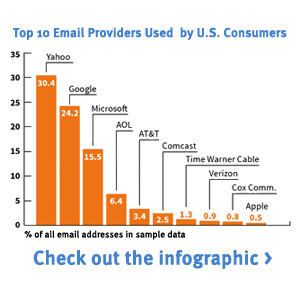
A goodbye at the store, a hello in your inbox
3. July 2013
The Publicare email analysis 2014 for the USA
5. March 2014
Spam traps, honeypots and trash domains
If you want to make sure your marketing emails actually get delivered, having a good sender reputation is the key. Those who enjoy a first-class sender reputation with email providers such as Gmail, Yahoo, and AOL can rest assured that their newsletters and promotions will land safely in the inboxes of their recipients. Companies with less favourable sender reputations may find that their emails are ending up in the spam folder instead of the inbox. The situation gets especially critical if you have been blacklisted as an email sender. In this case, the providers using this specific blacklist won’t send your emails to the intended recipients at all.
Now you might think that this is not a problem for companies who are careful never to write to contacts that have opted out from advertising emails, right? Wrong. Even these senders can inadvertently wind up on a blacklist, for example if a ‘spam trap’ is hidden within their mailing lists.
What are spam traps?
 Spam traps are email addresses that are used by email service providers and blacklist operators to identify potential spammers. To the untrained eye, these email addresses often don’t look any different to ‘normal’ email addresses. They don’t appear to be suspicious in any way. Sometimes a spam trap is simply an email address that was once registered and used by a real person, but has long since been abandoned. An email address can be reactivated and used as a spam trap approximately six to twelve months after it has been deactivated. The new owner of the spam trap, for example an email service provider or blacklist operator, takes precise note of the emails that arrive in the inbox of the reactivated email address.
Spam traps are email addresses that are used by email service providers and blacklist operators to identify potential spammers. To the untrained eye, these email addresses often don’t look any different to ‘normal’ email addresses. They don’t appear to be suspicious in any way. Sometimes a spam trap is simply an email address that was once registered and used by a real person, but has long since been abandoned. An email address can be reactivated and used as a spam trap approximately six to twelve months after it has been deactivated. The new owner of the spam trap, for example an email service provider or blacklist operator, takes precise note of the emails that arrive in the inbox of the reactivated email address.
Additional danger particularly lurks within purchased lists: honeypots. Honeypots are a special type of spam trap. These are email addresses which have never actually been used for communication, but have been published on the internet in places that a normal user does not see. As a rule, honeypots are only found by so-called ‘harvesters’. These are programmes that systematically search the Internet for email addresses to ‘harvest’ them for address lists that are subsequently sold.
Their sneaky strategy: if you write to a spam trap, the owner of the spam trap assumes that either your mailing list has not been cleaned up in a long time or that you are writing to honeypot addresses for which you could not possibly have received permission to contact. As a result, as a potential spammer, you’re likely to land on a blacklist and your email campaigns will no longer reach all of your recipients.
… and then there are trash email addresses
 Trash mail addresses are basically email addresses that are used for protection against unsolicited advertising. Imagine you want to download free software or some interesting information from the internet. To do so, you first need to register with an email address and you assume that after registering you’ll receive unwanted advertising emails. In this case you can use a trash email address, which you only use for this specific purpose. Using this trick enables you to register without unwanted advertising emails being sent to your ‘real’ email address.
Trash mail addresses are basically email addresses that are used for protection against unsolicited advertising. Imagine you want to download free software or some interesting information from the internet. To do so, you first need to register with an email address and you assume that after registering you’ll receive unwanted advertising emails. In this case you can use a trash email address, which you only use for this specific purpose. Using this trick enables you to register without unwanted advertising emails being sent to your ‘real’ email address.
Nowadays numerous providers of ‘throw-away’ email addresses exist.>/strong> These are email addresses which exist for a short period of time before they are deleted or sometimes subsequently transformed into spam traps.
Sending marketing emails to trash email addresses negatively affects the chances of your marketing emails to be delivered. Besides, do you want to send emails to people who think that your content is trash?
What can you do to avoid being blacklisted?
A good reputation is easily lost and difficult to regain. Getting removed from a blacklist is often a lengthy and tedious process. Here are our Top 5 tips to avoid being blacklisted via spam traps right from the beginning:
 1. Never send emails to rented or purchased lists.
1. Never send emails to rented or purchased lists.
Don’t do this, ever – even if the seller convincingly assures you that the email addresses come from entirely legal sources, are handpicked, and/or have a guaranteed opt-in. Sending emails in your name to contacts who haven’t given their consent to you to receive your advertising information is illegal. Even if in practice this might not result in any serious legal problems, you’ll certainly be faced with deliverability issues.
 2. Do not send emails to addresses that have previously returned a ‘hard bounce’.
2. Do not send emails to addresses that have previously returned a ‘hard bounce’.
The receiving email server will inform you if an email address you have written to does not exist or no longer exists. These ‘hard bounces’ are easy to recognise in many professional email delivery systems. Invalid email addresses in your mailing lists are not harmless. After a few months they can be reactivated into spam traps and create a whole lot of problems for you. With many email service providers, continuously high hard bounce rates will reduce your sender reputation and your emails may even be blocked.
 3. If you have not received a response for a long period of time, handle these email addresses separately.
3. If you have not received a response for a long period of time, handle these email addresses separately.
Recipients who have not reacted to your emails for many months may not be real recipients at all. But what if they are? If so, they are contacts that are obviously not interested in your offers or at least haven’t been interested for a long time. They either regularly delete your mails without opening them or punish your dogged persistence by clicking on the spam button. Both of these responses will damage your reputation as a sender. Therefore, don’t treat inactive email addresses the same way as all other email addresses. Remove them from your mailing list for your regular marketing communication. Be extremely careful with reactivation campaigns. Monitor these campaigns closely so that you can stop communication if necessary before too much damage occurs – and always take a second long hard look at your strategy. No doubt you’ve considered the financial potential that lies within your ‘sleeping’ contacts. But have you also thought about the long-term damage a reactivation campaign could cause to your sender reputation? How many emails from follow-up campaigns automatically land in spam folders instead of in your recipients’ inboxes? How many interactions and conversions are missed as a result?
 4. Be careful with email addresses that you haven’t written to for an extended period of time!
4. Be careful with email addresses that you haven’t written to for an extended period of time!
Email addresses you haven’t written to for an extended period of time (for example more than six months) may have since become spam traps without you even noticing it. If it has been a while since a contact has received an email from you, this means you won’t have received a hard bounce if the email has been deactivated in the meantime. Treat email addresses which you haven’t written to for a long time separately and with extreme caution.
 5. Find known spam traps and trash email addresses in your mailing list!
5. Find known spam traps and trash email addresses in your mailing list!
This is not as simple to do as you might think. We’ll gladly help you find the vast majority of spam traps and trash email addresses in your address book and help you to clean up your mailing lists.

